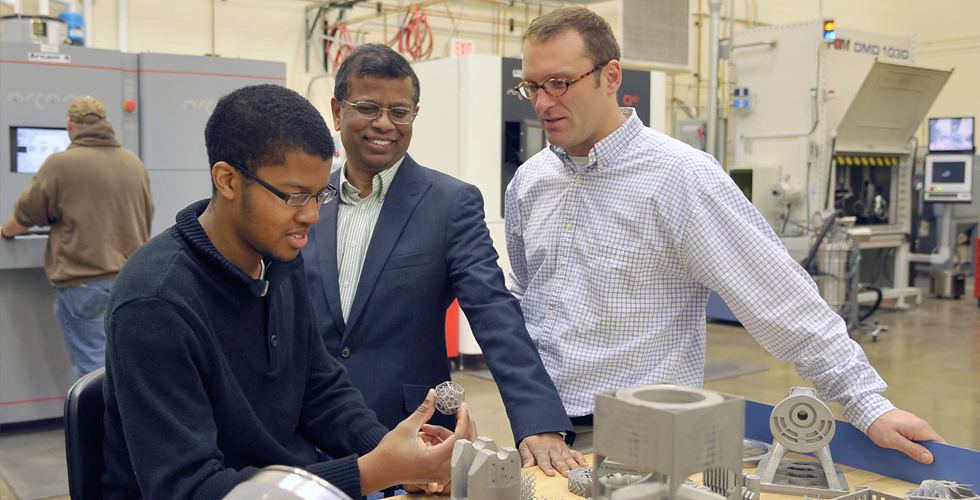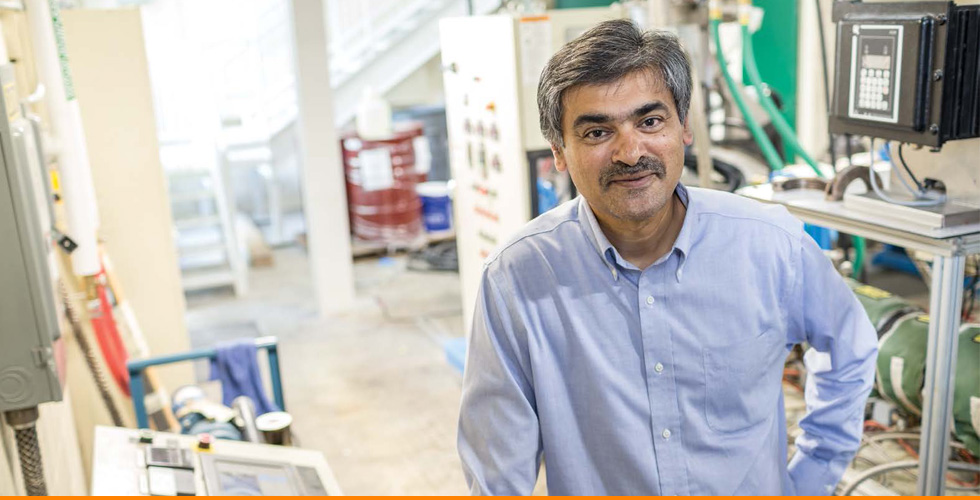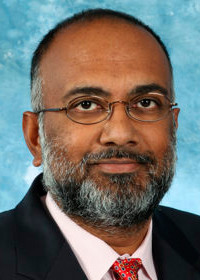Governors Chairs Driving New Wave of Manufacturing
There’s a new industrial revolution brewing, and UT is poised to be a leader in it. Advanced manufacturing, which uses emerging technology and innovations to transform traditional production methods, accounts for an ever-growing slice of the world’s economic pie.
“Through our centers, labs, and researchers we have built a reputation in a number of advanced manufacturing areas, from 3D printing to the use of new fibers and techniques,” said Taylor Eighmy, vice chancellor for research and engagement. “The Tickle College of Engineering and Oak Ridge National Laboratory have positioned us well.”
One impetus behind the effort is the UT-ORNL Governor’s Chair Program, with more than half of the fifteen current professors in the program devoted to advanced manufacturing, materials, or design.

Suresh Babu, who joined the college as the Governor’s Chair for Advanced Manufacturing in 2013, is one key component in those advances. Babu, who works out of the Departments of Mechanical, Aerospace and Biomedical Engineering and of Materials Science and Engineering, is considered an international expert in the field.
Babu specializes in 3D printing and joining novel materials, for which he has been named a fellow of the American Welding Society, a three-time honoree of their research of the year award, their lifetime achievement award, and most recently, the UT Battelle Joint Faculty Award. That expertise has helped UT land partnerships in advanced manufacturing with other universities and with agencies, such as the US Department of Energy and the US Air Force.
“Our partners and the work we do with them has allowed us to be among the pioneers of this new type of manufacturing,” said Babu. “Whether it’s through the use of cutting-edge machinery, materials, or techniques, we’ve been at the forefront of innovation.”

Uday Vaidya was the next Governor’s Chair appointee specific to the field, coming in 2015 as the Governor’s Chair in Advanced Composites Manufacturing. Vaidya’s success in expanding the field is perhaps best noted by the conversion of the former TANDEC facility on White Avenue into The Fibers and Composites Manufacturing Facility and Engineering Annex. That facility has a number of laboratories and machines that enable students to test new ideas and research, giving them critical hands-on experience.
Vaidya said such experiential learning was vital to the changing workforce because it allowed students to take research from a concept to a manufactured product.

Easo George is the most recent faculty member to join the cause, coming to UT as the Governor’s Chair for Advanced Alloy Theory and Development in December 2016. A former head of the Alloy Behavior and Design Group at ORNL, George brings four decades of experience working with advanced alloys and metals, key to the improvement of advanced manufacturing.
George said the strong relationship between UT and ORNL and the chance to help both continue to be pioneers in the field was one of the things that excited him about taking the position.
But it isn’t just faculty who are eagerly joining the transformation of manufacturing; being an early leader has also helped UT attract top talent in students, as well.
“We’ve seen tremendous growth in recent years, almost doubling in student population in just the last ten years,” said Wayne Davis, dean of the college. “The number of doctoral students we have is up almost 350 percent in that same span. “A lot of that growth has been due to our willingness to think ahead and address issues before they might be well known to the public, and undertaking advanced manufacturing in a serious manner has played a role in that.”
Several centers also have promoted UT’s role as a leader in advanced manufacturing techniques, including the UT-led IACMI—The Composites Institute. Since its launch in January 2015, UT has formed critical partnerships in areas related to advanced manufacturing, particularly automotive manufacturing, lightweight materials, and fiber composites.
Many of those partnerships again highlight UT’s connections with ORNL, serving to benefit both institutions.
“We’ve taken on the challenge of expanding leadership and growing our research capabilities when it comes to advanced manufacturing technology,” said Craig Blue, director of ORNL’s Energy Efficiency and Renewable Energy Programs. “Partnering with UT has been critical to that mission, enabling successful public-private partnership engagement models for driving innovation and American competitiveness.”
With recent economic reports showing that growth in advanced manufacturing jobs outpaced the economy as a whole, UT’s position in front of the curve is likely to benefit the university for years to come and give its graduates a leg up in an ever-competitive job market.